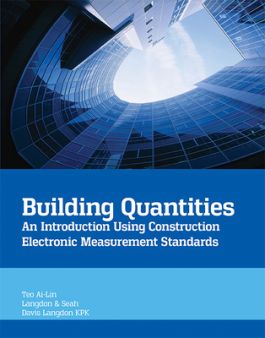Building Quantities, 3rd Edition
- Access the eBook anytime, anywhere: online or offline
- Create notes, flashcards and make annotations while you study
- Full searchable content: quickly find the answers you are looking for
About the Authors
Acknowledgement
Part I Introduction
1 Structure of the Book
2 Re-invention of the Construction Industry
3 Quantity Surveying Services
Part II Taking-Off: Principles of Measurement
4 Fundamentals of Measurement
5 Centre-line Method
Part II Taking-Off: Pitched Roof Building with Strip Foundation
6 Excavation Works and Concrete Work (Substructure)
7 Brickwork (Superstructure)
8 Finishes (Superstructure)
9 Doors and Windows (Superstructure)
10 Timber Pitched Roof (Superstructure)
Part II Taking-Off: Reinforced Concrete Roof Building with Pad Foundation
11 Excavation Works and Concrete Work (Substructure)
12 Brickwork (Superstructure)
13 Finishes (Superstructure)
14 Doors and Windows (Superstructure)
15 Concrete Work and Roofing (Superstructure)
16 Reinforcement (Substructure and Superstructure)
Part III Working-Up
17 Specifications
18 Bills of Quantities
Part IV E-Measurement and Exercises
19 E-Measurement
20 Exercises
Appendix
I Specification Notes and Drawings for Pitched Roof Building with Strip Foundation
II Specification Notes and Drawings for Reinforced Concrete Roof Building with Pad Foundation
III CEMS Cross Referencing to Chapter 6
IV CEMS Cross Referencing to Chapters 7 to 10
Annexes A–I
Index
The measurement of Building Works for preparation of Bills of Quantities has traditionally been a primary and distinct function of the quantity surveyor. However, since the mid-1990s, Bills of Quantities started to lose favour in Singapore’s construction industry in the wake of a prolific increase in design and build contracts and other alternative forms of procurement. Over the years, the range of professional quantity surveying services has expanded in response to clients’ changing needs. As a result, the significance of this art of “taking-off” quantities has been somewhat diluted. Nevertheless, measurement, where employed, remains an important aspect of the development process as it provides the proper basis for cost management.
The rapid progress of Information Technology (IT) in recent years has left little doubt that IT is vital for the construction industry’s continuing development. Being an industry that is both cost conscious and labour intensive, automation is definitely one of the main areas where IT is able to create a strong impact. The exciting prospects of Automated Quantity Taking-Off Systems (AQTS) have launched several industry-wide initiatives that are set to revolutionise the way measurement, an age-old task, will be performed. The launch of the SS CP 97: 2002 ConstructionElectronic Measurement Standards (CEMS) Part 1: SMM for Building Works completes the preliminary stage of this paradigm shift.
Despite the advancement of IT into the area of automated quantity taking-off, there is still a need for continuous learning and development of traditional measurement skills. AQTS, in essence, serves as a complementary instrument that replaces the “taking-off” process. Measurement knowledge is still needed for the preparation of Bills of Quantities and in postcontract cost administration. This book is for the benefit of those who are learning about measurement in academic institutions, those who are being introduced to measurement in their profession and those who are engaged in the development and advancement of measurement tools and software. This book presents a comprehensive overview of measurement techniques by concentrating on the basic principles and fundamental rules. This book, however, does notattempt to deal extensively with every trade or cover every situation that could arise in practice. Examples of taking-off and sample bills of quantities are included as additional illustrations. An insight into other facets of quantity surveying tasks is also included.
This book is also meant to be used in conjunction with the above-mentioned SS CP 97: 2002 Construction Electronic Measurement Standards (CEMS) Part 1: SMM for Building Works.

